SprintBoot学习(二)
Spring Boot的入口类
1、名为xxxApplication的就是入口类,在main方法中使用SpringApplication.run(SpringBootTestApplication.class, args);启动Spring Boot应用项目。
2、@SpringBootApplication是由@SpringBootConfiguration、@EnableAutoConfiguration、@ComponentScan的组合注解。其中@EnableAutoConfiguration让Spring Boot 根据类路径中的jar包依赖为当前项目进行自动配置。
Spring Boot定制banner
1、查找顺序:依次在 Classpath 下找 文件 banner.gif , banner.jpg , banner.png 和 banner.txt,都没有找到的话, 用默认的 SpringBootBanner , 就是我们最常见到的那个。
2、测试案例:
新banner.txt
${AnsiColor.BRIGHT_YELLOW}
////////////////////////////////////////////////////////////////////
// //
// ${AnsiColor.BRIGHT_RED}_ooOoo_${AnsiColor.BRIGHT_YELLOW} //
// ${AnsiColor.BRIGHT_RED}o8888888o${AnsiColor.BRIGHT_YELLOW} //
// ${AnsiColor.BRIGHT_RED}88${AnsiColor.BRIGHT_YELLOW}" . "${AnsiColor.BRIGHT_RED}88${AnsiColor.BRIGHT_YELLOW} //
// (| ^_^ |) //
// O\ = /O //
// ____/`---'\____ //
// .' \\| |// `. //
// / \\||| : |||// \ //
// / _||||| -:- |||||- \ //
// | | \\\ - /// | | //
// | \_| ''\---/'' | | //
// \ .-\__ `-` ___/-. / //
// ___`. .' /--.--\ `. . ___ //
// ."" '< `.___\_<|>_/___.' >'"". //
// | | : `- \`.;`\ _ /`;.`/ - ` : | | //
// \ \ `-. \_ __\ /__ _/ .-` / / //
// ========`-.____`-.___\_____/___.-`____.-'======== //
// `=---=' //
// ^^^^^^^^^^^^^^^^^^^^^^^^^^^^^^^^^^^^^^^^^^^^^^^^^^ //
// 佛祖保佑 永不宕机 永无BUG //
////////////////////////////////////////////////////////////////////
运行结果:
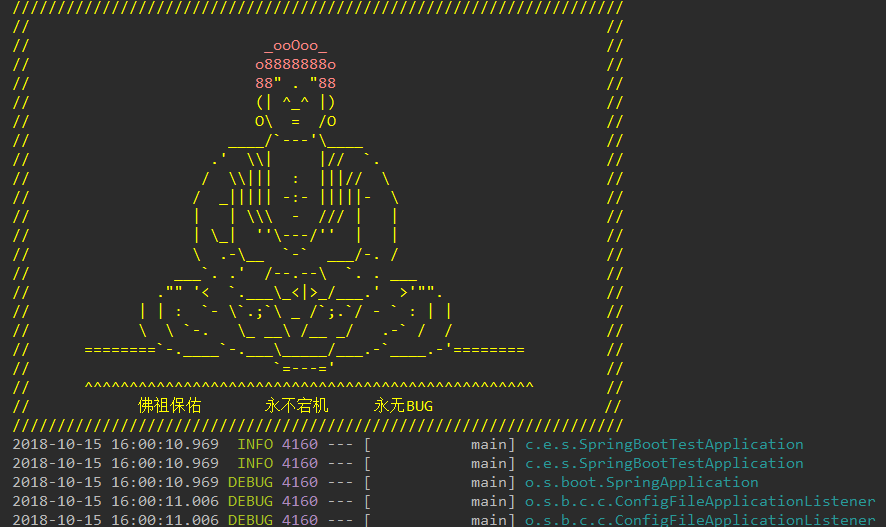
3、关闭banner
SpringApplication springApplication = new SpringApplication(SpringBootTestApplication.class);
springApplication.setBannerMode(Banner.Mode.OFF);
springApplication.run(args);
Spring Boot配置文件
1、Spring Boot使用一个全局的配置文件application.properties 或application.yml,作用是对一些默认配置的配置值进行修改。
2、profile配置:输Spring 针对不同的环境对不同的配置提供的支持,全局的profile配置使用application-{profile}.properties,通过application.properties中设置spring.profiles.active = prod来指定活动的profile。
测试案例:
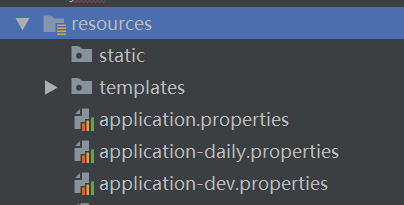
spring.profiles.active=daily
#修改访问路径
server.servlet.context-path=/springboot
my.username=Amy
3、日志配置:默认情况下使用Logback做为日志框架
测试案例:
spring.profiles.active=daily
#修改访问路径
server.servlet.context-path=/springboot
my.username=Amy
#指定日志文件保存地址
logging.file=D:/study/SpringBoot/log.log
debug=true
4、常规属性配置:在Spring环境下需要用@PropertySource来指定文件的位置再用@Value来指定注入的值。再Spring Boot 中只需要用@Value的注解
配置文件:
ser.nikename=Saber
user.age=21
启动类:
package com.example.spring_boot_test; import org.springframework.beans.factory.annotation.Value;
import org.springframework.boot.SpringApplication;
import org.springframework.boot.autoconfigure.SpringBootApplication;
import org.springframework.web.bind.annotation.RequestMapping;
import org.springframework.web.bind.annotation.RestController; @RestController
@SpringBootApplication//开启自动配置
public class SpringBootTestApplication { //通过@Value注入值
@Value("${my.username}")
private String userName; public static void main(String[] args) {
//关闭banner
/*SpringApplication springApplication = new SpringApplication(SpringBootTestApplication.class);
springApplication.setBannerMode(Banner.Mode.OFF);
springApplication.run(args);*/
SpringApplication.run(SpringBootTestApplication.class, args);
} @RequestMapping("/")
String index() {
return "hello " + userName + " spring boot !!!";
} }
5、类型安全的配置:如果每次使用@Value注解逐一注入属性会很麻烦,因此可以通过@ConfigurationProperties将properties属性和一个bean关联起来,从而实现类型安全的配置。
配置文件:
ser.nikename=Saber
user.age=21
类型安全的Bean:
package com.example.spring_boot_test.entity; import org.springframework.boot.context.properties.ConfigurationProperties;
import org.springframework.context.annotation.PropertySource;
import org.springframework.stereotype.Component; @Component//要使用这个注解,这样就可以在 component scan时候被发现了,不然会无法自动注入,
@PropertySource({"classpath:/my.properties"})//注意路径的书写格式
@ConfigurationProperties(prefix = "user")
public class User {
String nikename;
int age; public String getNikename() {
return nikename;
} public void setNikename(String nikename) {
this.nikename = nikename;
} public int getAge() {
return age;
} public void setAge(int age) {
this.age = age;
}
}
启动类:
package com.example.spring_boot_test; import com.example.spring_boot_test.entity.User;
import org.springframework.beans.factory.annotation.Autowired;
import org.springframework.beans.factory.annotation.Value;
import org.springframework.boot.SpringApplication;
import org.springframework.boot.autoconfigure.SpringBootApplication;
import org.springframework.web.bind.annotation.RequestMapping;
import org.springframework.web.bind.annotation.RestController; @RestController
@SpringBootApplication//开启自动配置
public class SpringBootTestApplication { @Autowired
private User user; //通过@Value注入值
@Value("${my.username}")
private String userName; public static void main(String[] args) {
//关闭banner
/*SpringApplication springApplication = new SpringApplication(SpringBootTestApplication.class);
springApplication.setBannerMode(Banner.Mode.OFF);
springApplication.run(args);*/
SpringApplication.run(SpringBootTestApplication.class, args);
} @RequestMapping("/")
String index() {
System.out.println(user.getNikename() + ":" + user.getAge());
return "hello " + userName + " spring boot !!!";
} }
Spring Boot运行原理
1、@SpringBootApplication是由@SpringBootConfiguration、@EnableAutoConfiguration、@ComponentScan的组合注解。核心功能由EnableAutoConfiguration提供。
- @Configuration:@SpringBootConfiguration的本质是@Configuration,@Configuration相当于把该类作为spring的xml配置文件中的
<beans>,作用为配置spring容器(应用上下文),任何一个标注了@Configuration的Java类定义都是一个JavaConfig配置类。 - @ComponentScan:@ComponentScan自动扫描并加载符合条件的组件(比如@Component和@Repository等)或者bean定义,最终将这些bean定义加载到IoC容器中。
- @EnableAutoConfiguration:@EnableAutoConfiguration的部分源码如下:
@Target(ElementType.TYPE)
@Retention(RetentionPolicy.RUNTIME)
@Documented
@Inherited
@AutoConfigurationPackage
@Import(AutoConfigurationImportSelector.class)
public @interface EnableAutoConfiguration { String ENABLED_OVERRIDE_PROPERTY = "spring.boot.enableautoconfiguration"; Class<?>[] exclude() default {}; String[] excludeName() default {}; }其中@Import注解将所有符合自动配置条件的bean定义加载到IoC容器,AutoConfigurationImportSelector通过getCandidateConfigurations方法来扫描具有MWTA-INF/spring.factories文件的jar包(spring-boot-autoconfigure.jar),spring.factories文件声明了自动配置。然后根据@EnableAutoConfiguration的完整类名org.springframework.boot.autoconfigure.EnableAutoConfiguration作为查找的Key,获取对应的一组@Configuration类,然后通过反射(Java Refletion)实例化为对应的标注了@Configuration的JavaConfig形式的IoC容器配置类,最后汇总为一个并加载到IoC容器。
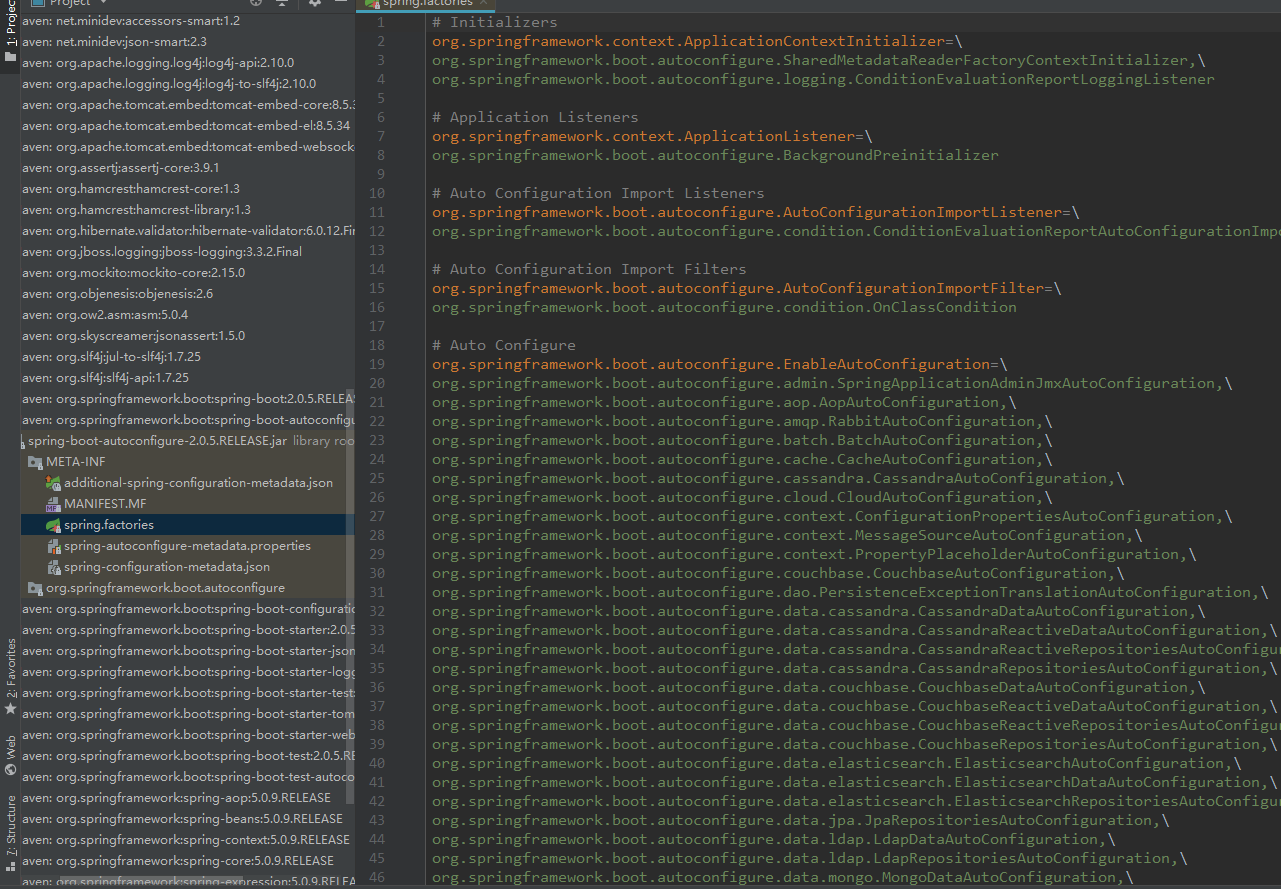
Spring Boot执行流程
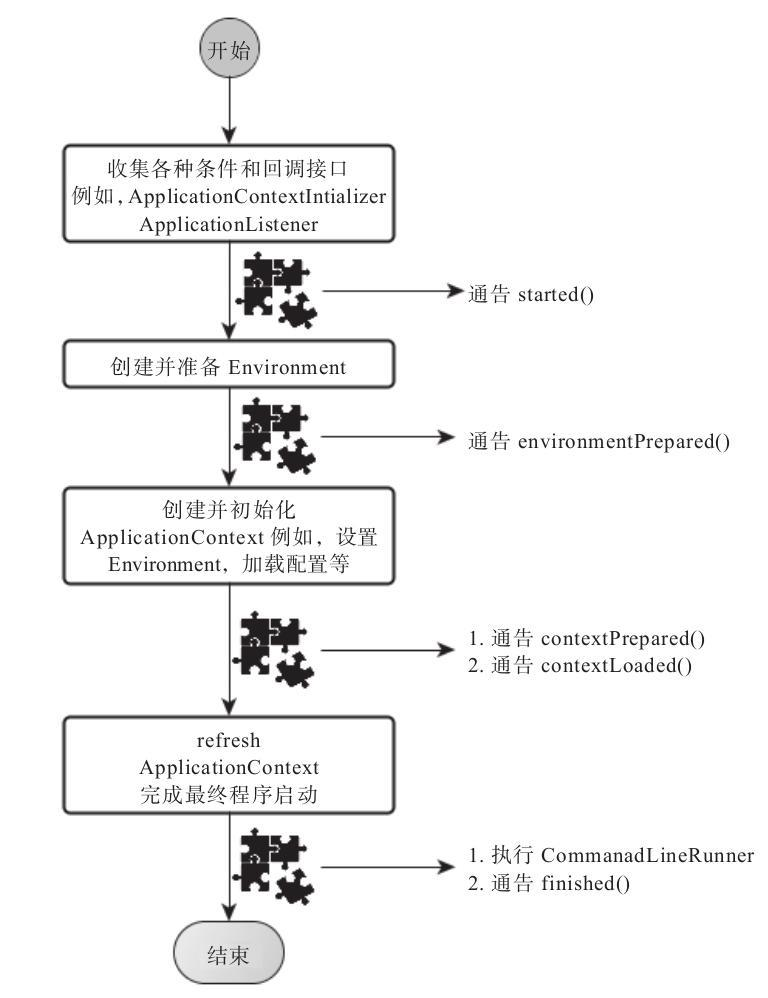
Spring Boot的执行流程主要分为两大部分:创建一个SpringApplication对象实例 ,调用这个创建好的SpringApplication的实例方法。

1、创建一个SpringApplication对象实例
public SpringApplication(Class... primarySources) {
//创建一个SpringApplication对象实例
this((ResourceLoader)null, primarySources);
}
public SpringApplication(ResourceLoader resourceLoader, Class... primarySources) {
this.sources = new LinkedHashSet();
this.bannerMode = Mode.CONSOLE;
this.logStartupInfo = true;
this.addCommandLineProperties = true;
this.headless = true;
this.registerShutdownHook = true;
this.additionalProfiles = new HashSet();
this.isCustomEnvironment = false;
this.resourceLoader = resourceLoader;
Assert.notNull(primarySources, "PrimarySources must not be null");
this.primarySources = new LinkedHashSet(Arrays.asList(primarySources));
//推断应用类型。
this.webApplicationType = this.deduceWebApplicationType();
//使用SpringFactoriesLoader在应用的classpath中查找并加载所有可用的ApplicationContextInitializer。
this.setInitializers(this.getSpringFactoriesInstances(ApplicationContextInitializer.class));
//使用SpringFactoriesLoader在应用的classpath中查找并加载所有可用的ApplicationListener。
this.setListeners(this.getSpringFactoriesInstances(ApplicationListener.class));
//通过抛出异常来获取到异常栈从而得到入口类的名称设置main方法的定义类。
this.mainApplicationClass = this.deduceMainApplicationClass();
}
2、调用这个创建好的SpringApplication的实例方法
public ConfigurableApplicationContext run(String... args) {
//计时开始
StopWatch stopWatch = new StopWatch();
stopWatch.start();
ConfigurableApplicationContext context = null;
Collection<SpringBootExceptionReporter> exceptionReporters = new ArrayList();
this.configureHeadlessProperty();
//获取所有通过SpringFactoriesLoader可以查找到并加载的SpringApplicationRunListener
SpringApplicationRunListeners listeners = this.getRunListeners(args);
listeners.starting();
Collection exceptionReporters;
try {
ApplicationArguments applicationArguments = new DefaultApplicationArguments(args);
//创建并配置当前Spring Boot应用将要使用的Environment(包括配置要使用的PropertySource以及Profile)。
//遍历调用所有SpringApplicationRunListener的environmentPrepared()的方法,告诉他们:“当前SpringBoot应用使用的Environment准备好了咯!”。
ConfigurableEnvironment environment = this.prepareEnvironment(listeners, applicationArguments);
this.configureIgnoreBeanInfo(environment);
//是否打印banner
Banner printedBanner = this.printBanner(environment);
// 创建上下文对象,根据用户是否明确设置了applicationContextClass类型以及初始化阶段的推断结果,决定该为当前SpringBoot应用创建什么类型的
context = this.createApplicationContext();
//异常报警
exceptionReporters = this.getSpringFactoriesInstances(SpringBootExceptionReporter.class, new Class[]{ConfigurableApplicationContext.class}, context);
//spring上下文对象的前置处理
this.prepareContext(context, environment, listeners, applicationArguments, printedBanner);
//spring上下文对象的刷新
this.refreshContext(context);
//spring上下文对象的后置处理
this.afterRefresh(context, applicationArguments);
//计算器关闭
stopWatch.stop();
if (this.logStartupInfo) {
(new StartupInfoLogger(this.mainApplicationClass)).logStarted(this.getApplicationLog(), stopWatch);
}
//遍历执行listeners,调用它们的started()方法,告诉这些SpringApplicationRunListener,“嘿,SpringBoot应用要开始执行咯!”。
listeners.started(context);
this.callRunners(context, applicationArguments);
} catch (Throwable var10) {
this.handleRunFailure(context, var10, exceptionReporters, listeners);
throw new IllegalStateException(var10);
}
try {
listeners.running(context);
return context;
} catch (Throwable var9) {
this.handleRunFailure(context, var9, exceptionReporters, (SpringApplicationRunListeners)null);
throw new IllegalStateException(var9);
}
Spring Boot中的starter pom
1、Spring Boot为我们提供了简化企业级开发的绝大多数场景的stater pom,只要使用了应用场景所需要的starter pom就会得到Spring Boot为我们提供的自动配置的bean。
2、自定义starter pom 测试案例:
- 新建maven工程
发尺寸
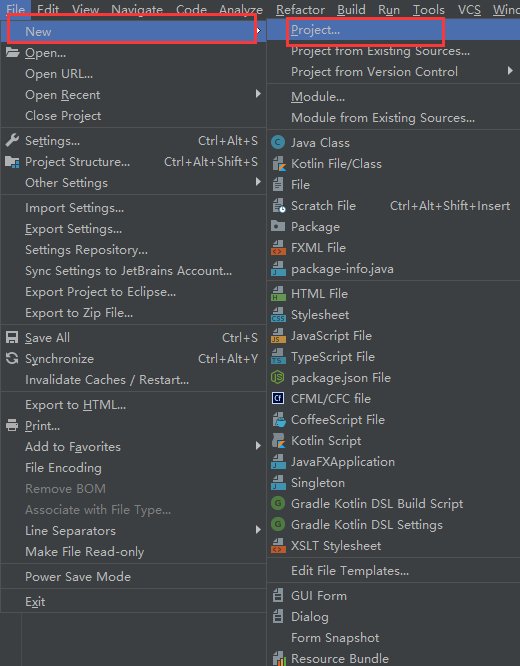

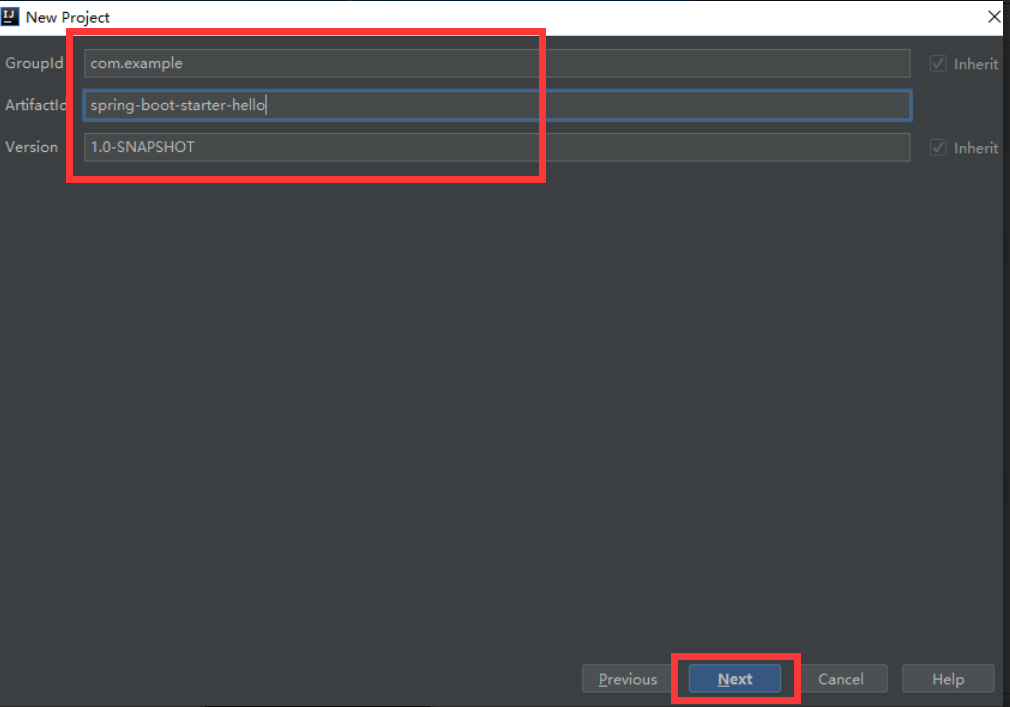
填写完工程名点击finish,工程创建完成
- 修改pom文件如下:
<?xml version="1.0" encoding="UTF-8"?>
<project xmlns="http://maven.apache.org/POM/4.0.0"
xmlns:xsi="http://www.w3.org/2001/XMLSchema-instance"
xsi:schemaLocation="http://maven.apache.org/POM/4.0.0 http://maven.apache.org/xsd/maven-4.0.0.xsd">
<modelVersion>4.0.0</modelVersion> <groupId>com.example</groupId>
<artifactId>spring-boot-starter-hello</artifactId>
<version>1.0-SNAPSHOT</version>
<packaging>jar</packaging>
<properties>
<project.build.sourceEncoding>UTF-8</project.build.sourceEncoding>
<project.reporting.outputEncoding>UTF-8</project.reporting.outputEncoding>
<java.version>1.8</java.version>
</properties>
<dependencies>
<dependency>
<groupId>org.springframework.boot</groupId>
<artifactId>spring-boot-autoconfigure</artifactId>
<version>1.4.3.RELEASE</version>
</dependency>
<dependency>
<groupId>org.springframework.boot</groupId>
<artifactId>spring-boot-configuration-processor</artifactId>
<version>1.4.3.RELEASE</version>
<optional>true</optional>
</dependency>
</dependencies>
<build>
<plugins>
<plugin>
<groupId>org.springframework.boot</groupId>
<artifactId>spring-boot-maven-plugin</artifactId>
</plugin>
</plugins>
</build> </project> - 属性配置:
package com.example.spring_boot_starter_hello; import org.springframework.boot.context.properties.ConfigurationProperties;
import org.springframework.context.annotation.PropertySource;
//类型安全的属性配置
@PropertySource({"classpath:/my.properties"})//注意路径的书写格式
@ConfigurationProperties(prefix = "hello")
public class HelloServiceProperties { private static final String MSG="world"; private String msg=MSG; public String getMsg() {
return msg;
} public void setMsg(String msg) {
this.msg = msg;
}
}是类型安全的属性配置与properties文件中的属性相对应。
- service类
package com.example.spring_boot_starter_hello; public class HelloService { private String msg; public String sayHello(){
return "hello "+msg;
} public String getMsg() {
return msg;
} public void setMsg(String msg) {
this.msg = msg;
}
} - 自动配置类
package com.example.spring_boot_starter_hello; import org.springframework.beans.factory.annotation.Autowired;
import org.springframework.boot.autoconfigure.condition.ConditionalOnClass;
import org.springframework.boot.autoconfigure.condition.ConditionalOnMissingBean;
import org.springframework.boot.autoconfigure.condition.ConditionalOnProperty;
import org.springframework.boot.context.properties.EnableConfigurationProperties;
import org.springframework.context.annotation.Bean;
import org.springframework.context.annotation.Configuration;
//@Configuration标注在类上,相当于把该类作为spring的xml配置文件中的<beans>,作用为:配置spring容器(应用上下文)
@Configuration
//开启属性输入
@EnableConfigurationProperties(HelloServiceProperties.class)
//判断HelloService这个类在类路径中是否存在,且在没有这个bean的情况下会自动配置这个bean
@ConditionalOnClass(HelloService.class)
//当设置hello=enable的情况下,如果没有设置默认为true,即条件符合
@ConditionalOnProperty(prefix = "hello",value = "enabled",matchIfMissing = true)
public class HelloServiceAutoConfiguration {
@Autowired
private HelloServiceProperties helloServiceProperties;
//使用Java配置的方式配置bean
@Bean
//当容器没有这个bean的时候会新建bean
@ConditionalOnMissingBean(HelloService.class)
public HelloService helloService(){
HelloService helloService = new HelloService();
helloService.setMsg(helloServiceProperties.getMsg());
return helloService;
}
} - 注册配置,在src/main/resources下新建META-INF/spring.factories,内容如下:
#注册自动配置类
org.springframework.boot.autoconfigure.EnableAutoConfiguration=\
com.example.spring_boot_starter_hello.HelloServiceAutoConfiguration - 使用starter 在之前的Spring Boot 中将自定义的starter作为依赖,在pom文件中新增spring-boot-stater-hello的依赖。修改pom文件如下:
<?xml version="1.0" encoding="UTF-8"?>
<project xmlns="http://maven.apache.org/POM/4.0.0" xmlns:xsi="http://www.w3.org/2001/XMLSchema-instance"
xsi:schemaLocation="http://maven.apache.org/POM/4.0.0 http://maven.apache.org/xsd/maven-4.0.0.xsd">
<modelVersion>4.0.0</modelVersion> <groupId>com.example</groupId>
<artifactId>spring-boot-test</artifactId>
<version>0.0.1-SNAPSHOT</version>
<packaging>jar</packaging> <name>spring_boot_test</name>
<description>Demo project for Spring Boot</description> <!--spring boot的父级依赖-->
<parent>
<groupId>org.springframework.boot</groupId>
<artifactId>spring-boot-starter-parent</artifactId>
<version>2.0.5.RELEASE</version>
<relativePath/> <!-- lookup parent from repository -->
</parent> <properties>
<project.build.sourceEncoding>UTF-8</project.build.sourceEncoding>
<project.reporting.outputEncoding>UTF-8</project.reporting.outputEncoding>
<java.version>1.8</java.version>
</properties> <dependencies>
<!--添加web依赖的起步依赖-->
<dependency>
<groupId>org.springframework.boot</groupId>
<artifactId>spring-boot-starter-web</artifactId>
</dependency> <dependency>
<groupId>org.springframework.boot</groupId>
<artifactId>spring-boot-starter-test</artifactId>
<scope>test</scope>
</dependency> <!--需要添加依赖ConfigurationProperties才会起作用-->
<dependency>
<groupId>org.springframework.boot</groupId>
<artifactId>spring-boot-configuration-processor</artifactId>
<optional>true</optional>
</dependency> <!--添加spring-boot-stater-hello的依赖-->
<dependency>
<groupId>com.example</groupId>
<artifactId>spring-boot-starter-hello</artifactId>
<version>1.0-SNAPSHOT</version>
</dependency> </dependencies> <!--添加springboot的编译插件-->
<build>
<plugins>
<plugin>
<groupId>org.springframework.boot</groupId>
<artifactId>spring-boot-maven-plugin</artifactId>
</plugin>
</plugins>
</build> </project>通过mvn install安装到本地,或者发布到远程maven私服上。
- 在properties文件中增加属性:hello.msg=hello
- 在Spring Boot中注入HelloService并使用
package com.example.spring_boot_test; import com.example.spring_boot_starter_hello.HelloService;
import org.springframework.boot.SpringApplication;
import org.springframework.boot.autoconfigure.SpringBootApplication;
import org.springframework.web.bind.annotation.RequestMapping;
import org.springframework.web.bind.annotation.RestController;
import javax.annotation.Resource; @RestController
@SpringBootApplication//开启自动配置
public class SpringBootTestApplication { @Resource
private HelloService helloService;
public static void main(String[] args) {
//关闭banner
/*SpringApplication springApplication = new SpringApplication(SpringBootTestApplication.class);
springApplication.setBannerMode(Banner.Mode.OFF);
springApplication.run(args);*/
SpringApplication.run(SpringBootTestApplication.class, args);
} @RequestMapping("hello")
String hello() {
return helloService.sayHello();
}
}
转载请于明显处标明出处
https://www.cnblogs.com/AmyZheng/p/9791552.html
SprintBoot学习(二)的更多相关文章
- emberjs学习二(ember-data和localstorage_adapter)
emberjs学习二(ember-data和localstorage_adapter) 准备工作 首先我们加入ember-data和ember-localstorage-adapter两个依赖项,使用 ...
- ReactJS入门学习二
ReactJS入门学习二 阅读目录 React的背景和基本原理 理解React.render() 什么是JSX? 为什么要使用JSX? JSX的语法 如何在JSX中如何使用事件 如何在JSX中如何使用 ...
- TweenMax动画库学习(二)
目录 TweenMax动画库学习(一) TweenMax动画库学习(二) TweenMax动画库学习(三) Tw ...
- Hbase深入学习(二) 安装hbase
Hbase深入学习(二) 安装hbase This guidedescribes setup of a standalone hbase instance that uses the local fi ...
- Struts2框架学习(二) Action
Struts2框架学习(二) Action Struts2框架中的Action类是一个单独的javabean对象.不像Struts1中还要去继承HttpServlet,耦合度减小了. 1,流程 拦截器 ...
- Python学习二:词典基础详解
作者:NiceCui 本文谢绝转载,如需转载需征得作者本人同意,谢谢. 本文链接:http://www.cnblogs.com/NiceCui/p/7862377.html 邮箱:moyi@moyib ...
- Quartz学习--二 Hello Quartz! 和源码分析
Quartz学习--二 Hello Quartz! 和源码分析 三. Hello Quartz! 我会跟着 第一章 6.2 的图来 进行同步代码编写 简单入门示例: 创建一个新的java普通工程 ...
- SpringCloud学习(二):微服务入门实战项目搭建
一.开始使用Spring Cloud实战微服务 1.SpringCloud是什么? 云计算的解决方案?不是 SpringCloud是一个在SpringBoot的基础上构建的一个快速构建分布式系统的工具 ...
- DjangoRestFramework学习二之序列化组件、视图组件 serializer modelserializer
DjangoRestFramework学习二之序列化组件.视图组件 本节目录 一 序列化组件 二 视图组件 三 xxx 四 xxx 五 xxx 六 xxx 七 xxx 八 xxx 一 序列化组 ...
- SpringMVC入门学习(二)
SpringMVC入门学习(二) ssm框架 springMVC 在上一篇博客中,我简单介绍了一下SpringMVC的环境配置,和简单的使用,今天我们将进一步的学习下Springmvc的操作. mo ...
随机推荐
- Python核心编程:8个实践性建议
前言 我们在用Python进行机器学习建模项目的时候,每个人都会有自己的一套项目文件管理的习惯,我自己也有一套方法,是自己曾经踩过的坑踩过的雷总结出来的,现在在这里分享一下给大家,因为很多伙伴是接触P ...
- Docker - Deepin中docker不能启动容器,-d也无效
问题重现 1. 搭建mysql docker run -p 3306:3306 --name docker-mysql-5.7 -v $PWD/conf:/etc/mysql/conf.d -v $P ...
- 第十篇 深入Python的dict和set(一)
- Duizi and Shunzi HDU
Duizi and Shunzi Time Limit: 6000/3000 MS (Java/Others) Memory Limit: 32768/32768 K (Java/Others) ...
- python 第三方库安装
1.首先安装pip 2.在cmd中找到pip的安装路径,(一般在python的scripts文件中) 3.pip install 第三方库名称
- 040_字符串连接符 041_条件运算符目 042_运算符优先级_逻辑与或优先问题 043_自动类型转化 044_强制类型转换 045_基本类型常见错误_溢出_L问题
040_字符串连接符 package test_package; /** * 字符串运算符 * @author * */public class TestOperator05 { public sta ...
- 前端——语言——Core JS——《The good part》读书笔记——第九,十章节(Style,Good Features)
第九章节 本章节不再介绍知识点,而是作者在提倡大家培养良好的编码习惯,使用Good parts of JS,避免Bad parts of JS.它是一篇文章. 本文的1-3段阐述应用在开发过程中总会遇 ...
- http://localhost:8080/sockjs-node/info?t=1556418283950 net:: ERR_CONNECTION_REFUSED(亲测有效~!)
如果你的项目没有用到sockjs,vuecli3 运行npm run serve 之后network里面一直调用一个接口:http://localhost:8080/sockjs-node/info? ...
- PHP基础学习笔记3
一.检索表单信息 PHP 中的 $_GET 和 $_POST 变量用于检索表单中的信息,比如用户输入 提交的表单: <form action="welcome.php" me ...
- SVN代码迁移到GITlab
==================================================================================================== ...
